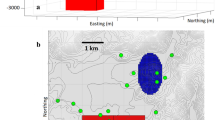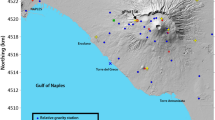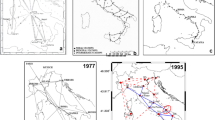Abstract
Geodynamic observatories around the globe continuously monitor signals like gravity, tilt and strain as a function of time. However, global signals are often masked by local effects, caused by the direct surroundings of the station, including the local geological setting. This link is well established for superconducting gravimeters (SG) that observe the gravity field variations at very high resolution. An enhancement of the SG time series by the application of local correction is exemplarily shown here in a very practicable procedure for the Geodynamic Observatory Moxa, Germany. We show how the combination of geological and gravimetrical mapping and modelling around Moxa results in a significant correction of the original gravity data, as can be proven by comparison with the satellite-derived gravity field. Detailed geological mapping of the observatory surroundings, including measurements of fold axes, foliations and joints, was the basis of the present study. The fold structure in the area of interest was interpreted by geometrical 3D modelling. The complete representation of different rock types in space also provides a better understanding of the local hydro-geological situation. Using a combination of the 3D geological model with the high-resolution Bouguer map of the observatory surroundings, we developed a 3D density model. This model enables the correction of small gravity effects caused by mass variations close to the SG, in particular local hydro-geological mass changes. Thus, the procedure presented here, based on a close connection of geology and gravimetry, is a powerful tool for the reduction of local gravity effects on SG recordings. It should be applicable to SG stations worldwide, where similar hydrologically driven mass changes can be assumed.
















Similar content being viewed by others
References
DIN 18125-LT (1986) Bestimmung der Dichte des Bodens, (Teil 1), 05/86
Dlugosch, R (2006) Kartierung von zeitlichen Variationen der elektrischen Bodenleitfähigkeit mit dem elektromagnetischen Slingram-Verfahren. Diplomarbeit, Institut für Geophysik der TU Clausthal (unpublished)
Franke W (1984) Structure of Variscannappes of the Münchberg Gneismasse area as derived from facies, deformation and degree of metamorphism of the surrounding region, in Geotectonic Research, vol 68. E. Schweizerbart’sche Verlagsbuchhandlung, Stuttgart
Franke W (1989) Variscan plate tectonics in Central Europe current ideas and open questions. Tectonophysics 169(1989):221–228
Gabriel G, Jahr T, Jentzsch G, Melzer J (1997) Deep structure and evolution of the Harz Mountains: results of three-dimensional gravity and finite-element modeling. Tectonophysics 270(3-4):279–299. doi:10.1016/S0040-1951(96)00176-X
Gebauer A, Kroner C, Jahr T (2009) The influence of topographic and lithologic features on horizontal deformations. Geophys J Int 177:586–602. doi:10.1111/j.1365-246X.2009.04072.x
Götze H-J (1976) Ein numerisches Verfahren zur Berechnung der gravimetrischen Feldgrößen für dreidimensionale Modellkörper. Dissertation, Institut für Geophysik der TU Clausthal
Götze H-J (1984) Über den Einsatz interaktiver Computergraphik im Rahmen 3-dimensionaler Interpretationstechniken in der Gravimetrie und der Magnetik. Institut für Geophysik der TU Clausthal, Habilitationsschrift
Götze H-J, Lahmeyer B (1988) Application of three-dimensional interactive modelling in gravity and magnetics. Geophysics 53(8):1096–1108. doi:10.1190/1.1442546
Hempel G (2003) Variszische Tektonik, in Geologie von Thüringen. In: Seidel G (eds) E. Schweizerbart’sche Verlagsbuchhandlung, Stuttgart, pp 192–206
Hofmann Y, Jahr T, Jentzsch G (2003) Three-dimensional gravimetric modelling to detect the deep structure of the region Vogtland/NW-Bohemia. J Geodyn 35(209):220. doi:10.1016/S0264-3707(02)00063-7
Jahr T, Jentzsch G, Kroner C (2001) The geodynamic observatory Moxa/Germany: instrumentation and purposes. J Geod Soc Japan 47(1):34–39
Jahr T, Kroner C, Lippmann A (2006) Strainmeters at Moxa observatory, Germany. J Geodyn 41(1–3):205–212. doi:10.1016/j.jog.2005.08.017
Jahr T, Jentzsch G, Weise A (2009) Natural and man-made induced hydrological signals, detected by high resolution tilt observations at the geodynamic observatory Moxa/Germany. J Geodyn 48(3–5):126–131. doi:10.1016/j.jog.2009.09.011
Kasch N (2006) Strukturgeologische Betrachtungen im nordwestlichen Teilabschnitt des Ziegenrück-Synklinoriums bei Moxa. Dipl.-Thesis, University of Jena, pp 78, URL:http://www.geo.uni-jena.de/moxa/Teil_1_Text.pdf
Kossmat F (1927) Gliederung des varistischen Gebirgsbaues. Abhandlungen des Sächsischen Geologischen Landesamtes Bd 1:1–39
Krause P, Fink M, Kroner C, Naujoks M (2009) The impact of hydrological processes on gravimetric measurements. J Hydrol 373(1–2):151–163. doi:10.1016/j.jhydrol.2009.04.019
Kroner C, Jahr T (2006) Hydrological experiments around the superconducting gravimeter at Moxa observatory. J Geodyn 41(1–3):242–252. doi:10.1016/j.jog.2005.08.012
Kroner C, Jahr T, Jentzsch G (2004) Results of 44 months of observations with a superconducting gravimeter at Moxa/Germany. J Geodyn 38(3–5):263–280
Kroner C, Jahr T, Naujoks M, Weise A (2007) Hydrological signals in gravity—foe or friend? In: Rizos C, Tregoning P (eds) Dynamic planet—monitoring and understanding a dynamic planet with geodetic and oceanographic tools, vol 130, IAG Symposia Series. Springer, pp 504–510
Liebe KT, Zimmermann E (1888) Geologische Specialkarte von Preußen und den Thüringischen Staaten, Blatt Ziegenrück mit Erläuterungen. Königlich Preußische Landesanstalt, Berlin
Linnemann U (2004) Das Saxothuringikum. Abriss der präkambrischen und paläozoischen Geologie von Sachsen und Thüringen. In: Linnemann U (ed) Geologica Saxonica, vol 48/49, 2nd edn. Staatliche Naturhistorische Sammlungen Dresden, Museum für Mineralogie und Geologie
Linnemann U, Lützner H, Heuse T, Kroner U (2002) Cadomiden und Varisziden des Thüringischen Schiefergebirges (Neoproterozoikum bis Unterkarbon). Jahresberichte und Mitteilungen des Oberrheinischen Geologischen Vereins, Stuttgart 84(191):223
Matte P (2001) The Variscan collage and orogeny (480 ± 290 Ma) and the tectonic definition of the Armorica microplate: a review. Terra Nova 13(2):122–128
Meinel, G (1995) Magmatismus und Metamorphose. In: Seidel G (Hrsg) Geologie von Thüringen. E. Schweizerbart`sche Verlagsbuchhandlung (Nägele und Obermiller), Stuttgart, pp 180–183
Naujoks, M (2008) Hydrological information in gravity: observation and modelling, Ph.D. thesis, Institute of Geosciences, Friedrich-Schiller-University Jena, URL:http://www.db-thueringen.de/servlets/DerivateServlet/Derivate-16661/Naujoks/Dissertation.pdf
Naujoks M, Weise A, Kroner C, Jahr T (2008) Detection of small hydrological variations in gravity by repeated observations with relative gravimeters. J Geodesy 82:543–553. doi:101007/s00190-007-0202-9
Naujoks M, Kroner C, Weise A, Jahr T, Krause P, Eisner S (2010) Evaluating local hydrological modelling by temporal gravity observations and a gravimetric three-dimensional model. Geophys J Int 182(1):233–249. doi:10.1111/j.1365-246X.2010.04615.x
Rosat S, Hinderer J, Crossley D, Boy J (2004) Performance of superconducting gravimeters from long-period seismology to tides. J Geodyn 38(3–5):461–476. doi:10.1016/j.jog.2004.07.005
Schmidt S (1996) 3D Modelling of Geoid and Gravity using GIS functions. Österreichische Beiträge zur Meteorologie und Geophysik. Wien 14:137–144
Schmidt S (2000) IGMAS. Interactive gravity and magnetic application system, online manual. http://www.gravity.uni-kiel.de/igmas/ Last access 08/06/14
Schroeder E (1966) Beiträge zur Schiefergebirgstektonik in Ostthüringen. In: Abhandlungen der Deutschen Akademie der Wissenschaften, Klasse für Chemie, Geologie und Biologie, 1965, 4; Abhandlungen zur Geotektonik, 23, Akademischer Verlag
Schulze, C (1998) Kleinräumige geophysikalische Untersuchungen im Bereich des seismologischen Observatoriums Moxa, Diplomarbeit, Institut für Geophysik der TU Clausthal, (unpublished)
Schwan W (1995) Untervorschiebung (Under-forward thrust)—Strukturtyp und Kinematik. Geologische Blätter NE-Bayern, Erlangen 45(1.2):11.102
Schwan W (1999) Zur strukturellen, kinematischen und zeitlichen Entwicklung der Frankenwälder Querzone im Thüringisch-Fränkischen Schiefergebirge—Neue Betrachtungen. Fragen und Stellungnahme, Geologische Blätter NE-Bayern, Erlangen 49(3–4):165–242
Teupser C (1975) The seismological station of Moxa. In: Seismology and solid-earth-physics, vol. 14, Veröffentlichungen des Zentralinstituts Physik der Erde (ZIPE), pp 577–584
Timmermann A (1978) Petrographische Untersuchungen an Grauwacken des Ziegenrücker Synklinoriums. Jahrbuch für Geologie 9(10):141–174
Torge W (1989) Gravimetry. Walter de Gruyter, Berlin
Wucher K (1997) Zur tektonischen Entwicklung des Südostteiles der Frankenwälder Querzone (Thüringisch-Fränkisches Schiefergebirge). Geowissenschaftliche Mitteilungen Thüringen, Weimar 6:21.155
Wucher K, Puff P, Steinmüller A (2001) Geologische Karte von Thüringen 1:25.000, no. 5335 Saalfeld (Saale). Thüringer Landesanstalt für Umwelt und Geologie, Jena
Zimmermann E (1912) Das Diluvium auf Blatt Saalfeld mit Erläuterungen, Jahrbuch der Königlich Preußischen Landesanstalt, Berlin für 1909
Acknowledgments
We thank R. Dlugosch, H. Hartmann, A. Hegewald, A. Weise, and S. Zeumann, who participated in the gravity measurements, and H.-J. Götze and S. Schmidt for helpful discussions concerning the Bouguer and free-air anomaly as well as the software package IGMAS. T. Heuse, J. Ellenberg, K. Götze, F. Jähne and I. Zander supported our work with geological discussion, which is gratefully acknowledged. We are indebted to the technical staff of the Geodynamic Observatory Moxa, Matthias Meininger and Wernfrid Kühnel for providing housing during the field work and a lot of scientific discussion. We thank reviewer A.G. Dehghani and one anonymous reviewer for their useful corrections and suggestions.
Author information
Authors and Affiliations
Corresponding author
Rights and permissions
About this article
Cite this article
Kasch, N., Naujoks, M., Kley, J. et al. Combined geological and gravimetric mapping and modelling for an improved understanding of observed high-resolution gravity variations: a case study for the Global Geodynamics Project (GGP) station Moxa, Germany. Int J Earth Sci (Geol Rundsch) 102, 1257–1270 (2013). https://doi.org/10.1007/s00531-012-0859-z
Received:
Accepted:
Published:
Issue Date:
DOI: https://doi.org/10.1007/s00531-012-0859-z




